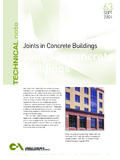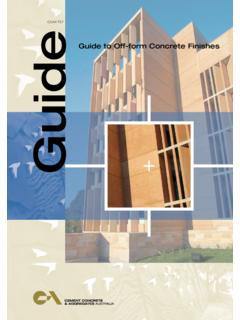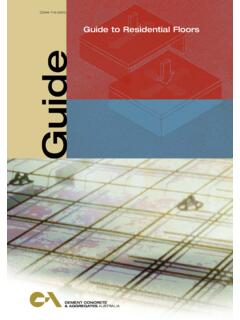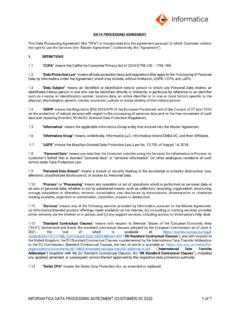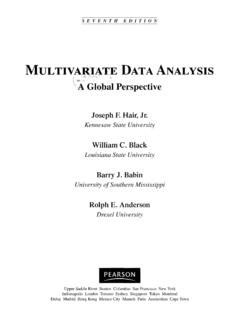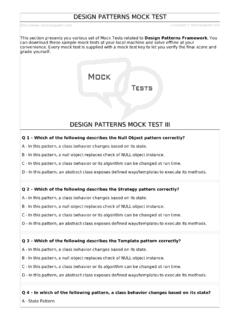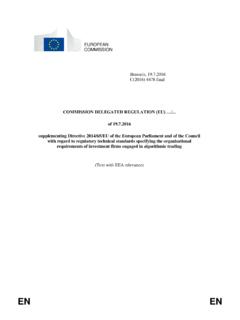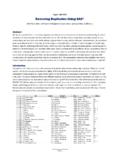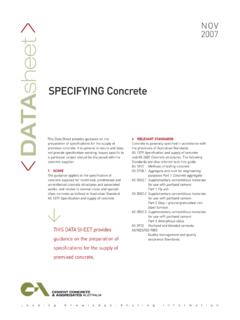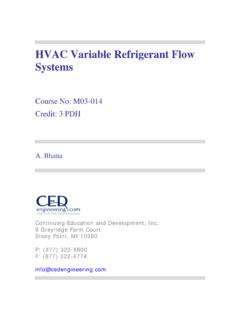Transcription of Data Sheet Tolerance for Concrete Surfaces
1 TOLERANCES for Concrete SurfacesINTRODUCTION Tolerances are provided to ensure the finished Concrete surface is acceptable for the application and the intended function. Setting tolerances also demonstrate that some degree of variation is inherent in all building work. The position of the Concrete element, its function, appearance and the influence of these on the total project would, in many cases, define the appropriate tolerances. On the other hand, tolerances must also be reasonable, both achievable and able to be checked in the field using the available techniques and at acceptable cost.
2 The importance of specifying appropriate tolerances becomes apparent when the outcome fails to meet the original expectations. Some Australian Standards specify tolerances for Concrete Surfaces and it is important to understand their relevance or limitation for particular applications. This Datasheet reviews the Tolerance requirements in various codes and standards, provides guidance on appropriate tolerances (particularly for unformed Surfaces ) and discusses the issues involved in achieving the specified tolerances.
3 DEFINITIONS Formed Surface: A Surface requiring formwork to provide shape and texture/finish to the Concrete . Unformed Surface: A surface that does not require formwork to provide either shape or finish to the surface, the top surface of slabs or pavements. These Surfaces generally have to meet two independent Tolerance criteria: the flatness of the surface and variation from the designed elevation (levelness). Flatness: The deviation of the surface from a straight line joining two points on the surface.
4 Levelness (elevation Tolerance ): The permitted vertical variation of the surface from a fixed external reference point or datum. Assessing Tolerances: It should be noted that measurement for assessment of as-constructed tolerances must be made within 24 hours to 72 hours of construction. The reason for this is that factors, outside of the construction process may influence measurements made outside of this time period ( release of propping on suspended slabs and beams, ground movement under slabs cast on ground, shrinkage and curling effects etc.)
5 In the case of columns and walls, measurement should take place as soon as is possible after formwork removal. MEASURING TOLERANCES As the specification of tolerances is dependent on the method of measurement, this is usually determined first. While the two common methods used in Australia are the optical and straightedge, methods include: Optical Optical survey instruments can be used to measure the levelness, flatness, position or plumb of an element. For pavement or slab levelness and flatness, spot checks on a grid TOLERANCS can be defined as the allowable variations from the specified values or performance levels.
6 2018 J U L Y PAGE 2 OF 10 > TOLERANCES FOR Concrete Surfaces pattern are often made. If relying entirely on spot measurements, the grid size may be quite small, say Combined with a straightedge, readings may be taken on, say, a 3m grid, with a straightedge used to check the variation between measured points. Instruments can have an accuracy of , and computer topographical maps drawn indicating slab contours to assist with the evaluation. Since small grid sizes may be required, the cost of this method should be evaluated, particularly when used over large areas.
7 Straightedge Tolerances can be determined by placing a straightedge anywhere on a Concrete surface in any direction and measuring the maximum deviation of the surface from the straightedge (see Figure 1). The use of a 3m straightedge has been found to be a simple and generally satisfactory method of measurement in Australia. A shorter length ( to 15m) straightedge is one of the methods for measuring surface tolerances of formed Concrete prescribed by AS The variation from the straightedge is typically expressed as a maximum deviation value over the straightedge length but can be assessed by the method provided in ACI 1174.
8 Figure 1: Testing the surface for compliance using a straightedge. While the 3m straightedge technique is simple, inexpensive and widely used, one of the deficiencies of the method includes the difficulty in testing large pavement areas. Other deficiencies include inability to reproduce test results and failure of the method to assess the acceptability of irregularities such as steps and surface undulations (often referred to as waviness see Figure 2). The length of the undulations in an unformed slab surface is an important consideration when choosing the length of a straight edge.
9 Shorter (300mm and1500mm) straightedges as specified in AS for formed Surfaces could be used provided the length of the straightedge exceeds the maximum length of undulations. It is common for the length of undulations n the unformed surface of slabs to vary from 600mm to 3m, so care should be taken when selecting a straightedge less than 3m for this assessment (see Figure 2). Figure 2: 3m straightedge tolerances fail to assess surface undulations (waviness). A better method of using a 3m straightedge and assessing its resulting test data is provided in ACI 1174.
10 This standard recognises the difficulties is assessing straightedge data and recommends that two limits are applied for flatness Tolerance . These are based on a standard approach to measuring the slab surface and the proposed deviation limits that are the limit at which 90% of the test measurements are less than and also the limit which 100% of the test measurements are less than. This approach to assessment is reflected in Table 1 overleaf, and used here to compare straightedge data with that from instruments used to measure flatness numbers and levelness numbers.

